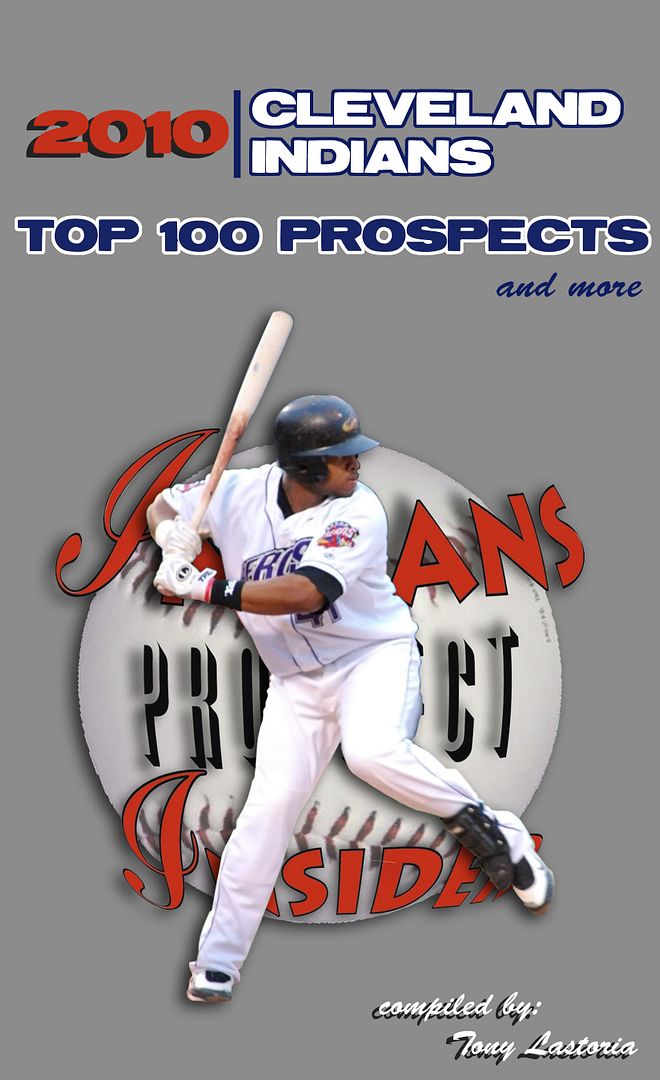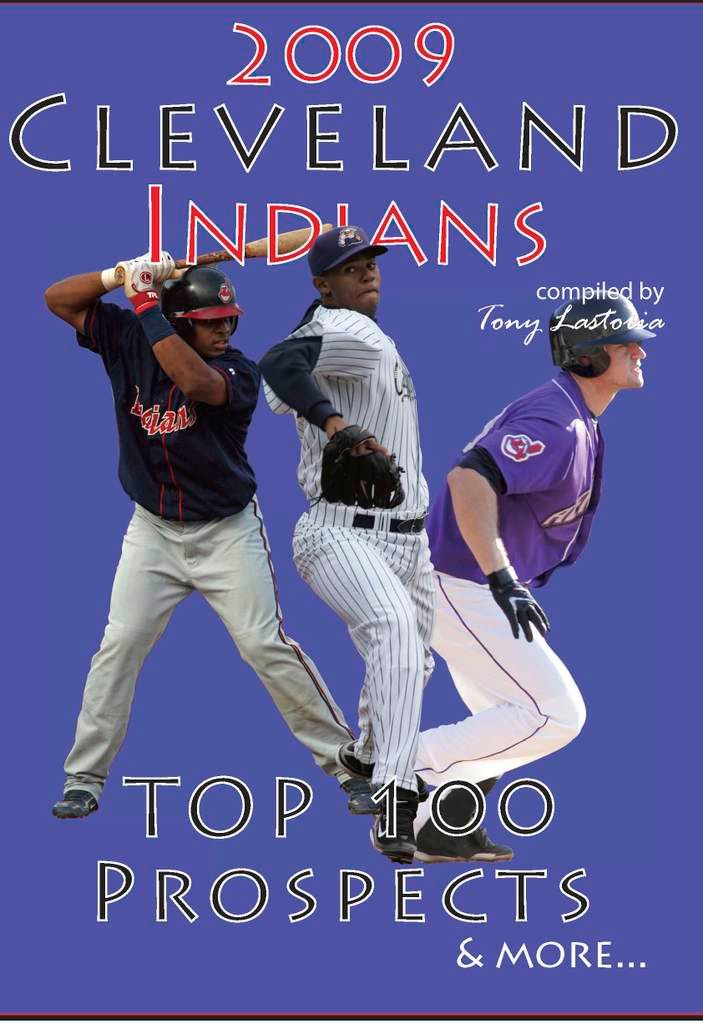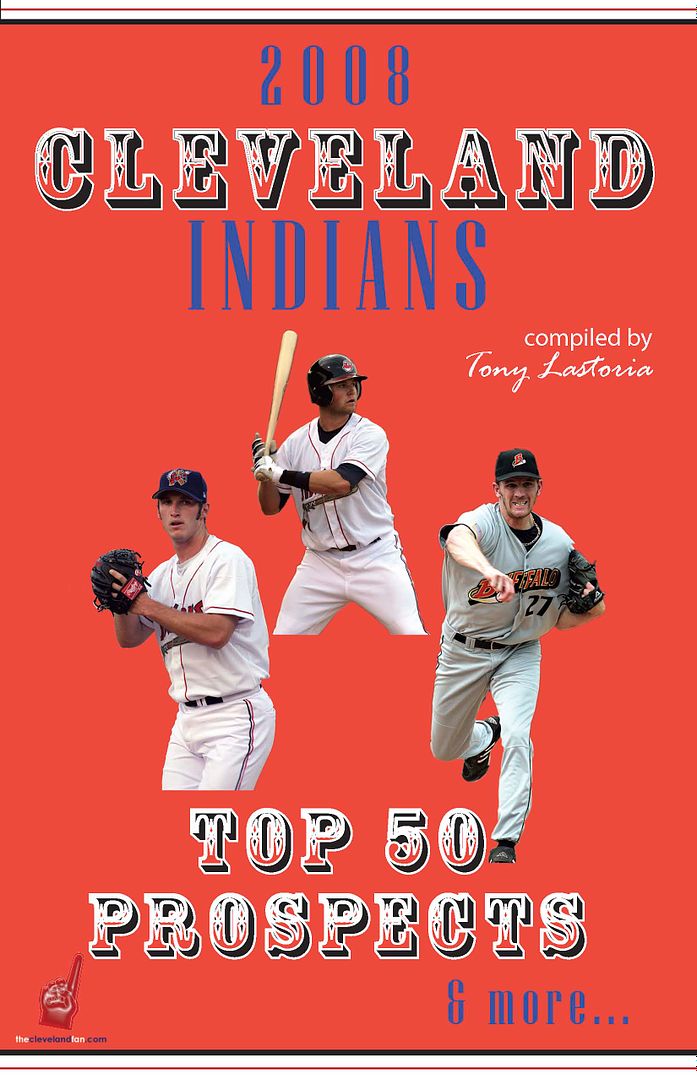Brad Snyder: Outfielder
Age: 24 Height: 6’3” Weight: 200 Bats: Left Throws: Left
Stats & Stuff: The Indians drafted Snyder in the 1st round (31st overall) of the 2003 Draft out of Ball State University. Although they dipped slightly, his 2006 numbers were pretty much a carbon copy of his 2005 numbers. In 2005, Snyder hit a combined .279/.354/.495 with 22 HRs and 82 RBIs combined at Kinston and Akron. Last year, Snyder hit .270/.351/.446 with 18 HRs and 72 RBIs in a return trip to Akron. Also, last year Snyder walked 62 times and struckout 158 times in 523 at bats, compared to walking 49 times and striking out 158 times in 513 at bats in 2005. The 158 strikeouts at Akron last year set a club record. Prior to being drafted, he was the 2003 Mid-American Conference Player of the Year.
The Good: Snyder’s stock fell somewhat last year, but the power and physical abilities are there. He comes in ranked above John Drennen mainly because of his power bat as well as his superior defense and base-running. Snyder’s compact stroke generates excellent bat speed, and he has very good power to all fields. His swing is geared for pitches in the zone, and when he stays within himself he hits almost everything hard. Snyder has good speed, which plays up due to his very good instincts on the basepaths. Snyder has mostly played center-field during his time with the Indians, but his power bat and plus arm project him as a major league right-fielder.
With special attention placed on his two-strike approach last season, Snyder consistently hit balls hard the other way. He also was shortening up on his swing, and taking what he was being given and going with pitches, which is something he hardly ever had done in the past. Around mid-season last year, the Indians decided to move Snyder up in the lineup to the leadoff spot from his normal 3-4 spot in the order. The idea behind the move was to get him to see more fastballs and protect him for the time being from seeing multiple pitch types each at bat. The shift in the lineup helped Snyder with his two-strike approach, and the results after the shift were favorable. It was definitely a grind for Snyder last season to work and develop his two strike approach, but like a lot of things in baseball there were good things happening last year with Snyder beyond the numbers.
The Bad: The reason Snyder returned to Akron in 2006 was to work on his two-strike approach and plate discipline. While there were some positives mentioned above with the advancement of his two-strike approach, the progress shown was limited and the strikeout total is still a huge concern. With his lack of discipline, he is still very susceptible to high and outside pitches and pitches in the dirt. In addition to his two-strike approach, the Indians worked extensively with Snyder last year on controlling his front hip and shoulder since he has a habit of pulling it too soon, which results in an incorrect bat path.
The Outlook: When Dave Hudgens came on board as the Minor League Hitting Coordinator last year, he implemented an organization-wide philosophy of drawing walks 10 percent of the time. With the addition of this new hitting philosophy, the idea was for hitters to develop a more patient hitting approach and work counts. One of the players targeted with this new philosophy was Brad Snyder, and while he struggled at times last year he did show some improvement with his 62 walks. The last thing missing in Snyder’s game is the two-strike approach and plate discipline, and it is something he will continue to work on at Buffalo in 2007.
skip to main |
skip to sidebar
 Everything on this site is free, but for those interested in making any monetary contributions to help support the stability and growth of this site please click on the "Donate" button below.
Everything on this site is free, but for those interested in making any monetary contributions to help support the stability and growth of this site please click on the "Donate" button below.
- Forum
- Affiliates
- Draft
- Stats
- Transactions
- Reference
- Rankings
- Depth Chart
- Payroll
Available IPI Books
IPI's Breaking Newswire
Support the IPI!
 Everything on this site is free, but for those interested in making any monetary contributions to help support the stability and growth of this site please click on the "Donate" button below.
Everything on this site is free, but for those interested in making any monetary contributions to help support the stability and growth of this site please click on the "Donate" button below.
Labels
- 1968 cleveland indians (3)
- 1981 Draft (1)
- 1982 Draft (1)
- 1983 Draft (1)
- 1984 Draft (1)
- 1985 Draft (1)
- 1986 Draft (1)
- 1987 Draft (1)
- 1988 draft (2)
- 1989 Draft (1)
- 1990 Draft (1)
- 1991 Draft (1)
- 1991 indians (1)
- 1992 Draft (1)
- 1993 Draft (1)
- 1993 indians (1)
- 1994 Draft (1)
- 1995 draft (1)
- 1996 draft (1)
- 1997 Draft (1)
- 1998 Draft (1)
- 1998 indians (1)
- 2003 indians (1)
- 2008 Transactions (1)
- 2009 Playoff Stats (2)
- 2009 Spring Training Games (20)
- 2009 Transactions (1)
- 2010 Draft (11)
- 2010 Instructional League (20)
- 2010 Prospect Book (8)
- 2010 spring training games (19)
- 2010 Transactions (1)
- 2011 Arizona Fall League (41)
- 2011 Champions (1)
- 2011 Draft (13)
- 2011 Draft News (29)
- 2011 Instructional League (29)
- 2011 organizational reports (4)
- 2011 Playoffs (5)
- 2011 prospect book (13)
- 2011 ranking (1)
- 2011 spring training (7)
- 2011 Transactions (5)
- 2012 Book (1)
- 3 up 3 down (3)
- A.J. Cole (1)
- Aaron Cunningham (3)
- Aaron Fields (2)
- Aaron Harang (2)
- Aaron Holbert (5)
- Aaron Laffey (13)
- Aaron Siliga (1)
- Abel Guerrero (5)
- Abner Abreu (55)
- Adam Abraham (25)
- Adam Davis (11)
- Adam Everett (5)
- Adam Griffin (1)
- Adam Miller (79)
- Adam White (6)
- AFL (1)
- Aflac (1)
- Akron (28)
- albie lopez (1)
- Alex Escobar (1)
- Alex Gonzalez (1)
- Alex Kaminsky (2)
- Alex Lavisky (15)
- Alex Monsalve (4)
- Alex White (66)
- Alexander Perez (32)
- Alexander Torres (1)
- all-star game (1)
- Allen Craig (2)
- Anderson Hernandez (6)
- Andrew Humphries (2)
- Andrew Means (1)
- Andrew Shive (3)
- Andrew Triggs (2)
- Andruw Jones (3)
- Andy Cannizaro (1)
- andy gonzalez (1)
- Andy LaRoche (1)
- Andy Marte (23)
- Aneury Rodriguez (1)
- Anillins Martinez (2)
- Anthony Gallas (7)
- Anthony Reyes (25)
- Anthony Santander (2)
- Antwonie Hubbard (3)
- Aramis Ramirez (1)
- arbitration (1)
- Argenis Martinez (6)
- Argenis Reyes (3)
- Arizona Fall League (15)
- Arizona League (3)
- Arizona Parallel League 2009 (10)
- Armando Camacaro (1)
- Around the Farm (356)
- Asdrubal Cabrera (28)
- Austin Adams (27)
- Austin Diemer (1)
- Austin Kearns (16)
- awards (9)
- AZL Indians (4)
- B.J. Upton (5)
- Barret Loux (1)
- Bartolo Colon (2)
- Baseball America (7)
- Baseball Prospectus (2)
- Beau Mills (65)
- Ben Carlson (5)
- Ben Copeland (2)
- Ben Francisco (9)
- Ben Holmes (1)
- Ben Lively (1)
- Ben Wetzler (1)
- Bert Blyleven (2)
- Betancourt (1)
- Billy Traber (1)
- Blaine Neal (1)
- Blaine O'Brien (4)
- Bo Greenwell (29)
- Bob Feller (2)
- Bobby Livingston (3)
- Bobby Valentine (2)
- Bobby Wahl (2)
- Book (6)
- Brad Grant (4)
- Brad Hinkle (1)
- Brad Snyder (8)
- brandon phillips (2)
- Brandon Pinckney (1)
- breaking news (51)
- Brett Brach (16)
- Brett Wallace (1)
- Brian Barton (10)
- Brian Bixler (6)
- Brian Buscher (1)
- Brian Grening (1)
- Brian Hansen (1)
- Brian Heere (2)
- Brian Horwitz (1)
- Brian Juhl (5)
- Brian Ruiz (3)
- Brian Slocum (5)
- Brock Simpson (3)
- Brock Stassi (2)
- Bryan Price (17)
- Bryce Brentz (1)
- Bryce Harper (1)
- Bryce Stowell (42)
- Bryson Myles (12)
- Bryson Smith (1)
- Bubba Bell (2)
- Bubbie Buzachero (1)
- buddy bell (1)
- Buffalo Bisons (3)
- bullpen (1)
- Burch Smith (2)
- Carl Pavano (1)
- Carlos Beltran (3)
- Carlos Carrasco (45)
- Carlos Lee (3)
- Carlos Moncrief (10)
- Carlos Pena (4)
- Carlos Rivero (33)
- Carlos Santana (76)
- Carlton Smith (21)
- Carolina Mudcats (4)
- Casey Blake (1)
- Casey Frawley (8)
- Casey Kotchman (9)
- CBA (1)
- CC Sabathia (2)
- Chad Durbin (3)
- Chad Huffman (12)
- chad paronto (1)
- Chad Rodgers (1)
- Charles Nagy (4)
- Chase Burnette (6)
- Chen-Chang Lee (24)
- Chin-Lung Hu (1)
- Chris Kersten (4)
- Chris Antonetti (6)
- Chris Archer (7)
- Chris Gimenez (41)
- Chris Heisey (2)
- Chris Iannetta (1)
- Chris Jones (13)
- chris magruder (1)
- Chris Nash (10)
- Chris Perez (10)
- Chris Ray (1)
- Chris Sale (1)
- Chris Seddon (1)
- Chris Tremie (2)
- Christian Colon (1)
- Christian Powell (1)
- Christopher Beck (1)
- Christopher Bradford (1)
- Christopher Waylock (2)
- Chuck Galeti (1)
- Chuck Lofgren (65)
- chun (1)
- Chun-Hsiu Chen (40)
- Cirilo Cumberbatch (2)
- Clayton Cook (20)
- Clayton Cook blog (1)
- Clayton Ehlert (1)
- Cleveland Cavaliers (1)
- Cleveland Indians (46)
- cliff lee (9)
- Clip and Dirty (29)
- Coaching staff (4)
- Coaching Staffs (1)
- Cody Allen (8)
- Cody Anderson (3)
- Cody Bunkelman (1)
- Cody Elliott (3)
- Cole Cook (6)
- Cole Pitts (2)
- Columbus (66)
- Connor Graham (19)
- Cord Phelps (62)
- Corey Embree (2)
- Corey Kluber (21)
- Cory Burns (29)
- Cory Embree (1)
- Cristo Arnal (1)
- Dale Dickerson (1)
- Dallas Cawiezell (8)
- Damaso Espino (3)
- Dan Cevette (5)
- Dan DeGeorge (1)
- Dan Wheeler (3)
- Daniel Jimenez (3)
- Daniel Morales (1)
- Danny Salazar (14)
- Dante Gentile (1)
- danys baez (1)
- Dave DeFreitas (1)
- Dave Hudgens (2)
- Dave Miller (4)
- Dave Wallace (1)
- david bell (1)
- David Goforth (1)
- David Huff (50)
- david riske (1)
- David Roberts (5)
- David Wright (1)
- Delvi Cid (12)
- Demarcus Tidwell (1)
- denis boucher (1)
- Denny Montero (1)
- Depth chart (7)
- Derek Lowe (4)
- Derrek Lee (4)
- Detroit Tigers (2)
- Dick Jacobs (2)
- Diego Seastrunk (3)
- Dillon Howard (10)
- Dillon Peters (7)
- Dioris Robles (1)
- Dominican Summer League (3)
- Donnie Webb (14)
- Dorssys Paulino (2)
- Doug Mathis (2)
- Doug Pickens (7)
- Draft (1)
- Draft History (1)
- Draft Retrospective (1)
- Drew Pomeranz (51)
- Drew Rucinski (1)
- Drew Sutton (3)
- DSL (1)
- DSL Indians (4)
- Dustin Realini (5)
- Dwight Childs (3)
- Earl Snyder (1)
- Eddie Burns (4)
- Eddie Mujica (4)
- Edgar Pineda (1)
- Eduardo Perez (1)
- Edward Salcedo (5)
- Edwin Rodriguez (2)
- Elliot Johnson (1)
- Ellis Burks (1)
- Elvis Araujo (14)
- Eric Berger (36)
- Eric Chavez (1)
- Eric Haase (5)
- Eric Wedge (2)
- Erik Stiller (16)
- Estevenson Encarnacion (1)
- Evan Frazar (2)
- Ezequiel Carrera (20)
- Fausto Carmona (20)
- felix fermin (1)
- Felix Pie (3)
- Felix Sterling (7)
- Francisco Jimenez (6)
- Francisco Lindor (11)
- Francisco Miguel (1)
- Francisco Valera (1)
- Frank DeJiulio (2)
- Frank Herrmann (31)
- Fred Lewis (2)
- Gaby Sanchez (3)
- Game Recaps (45)
- Garrison Campfield (3)
- General Minor League Info (2)
- Geoffrey Davenport (3)
- ghosts of prospects past (7)
- Gibson (1)
- Gio Gonzalez (1)
- Giovanni Soto (21)
- Giovanny Urshela (10)
- Goodyear (1)
- Grady Sizemore (33)
- Grant Sides (4)
- Greg Aquino (1)
- Greg Folgia (7)
- Greg Hibbard (1)
- Gregorio Petit (3)
- Gregorio Rosario (3)
- Gregory Folgia (3)
- hank peters (1)
- Hanley Ramirez (1)
- Harmon Killebrew (1)
- Harold Guerrero (1)
- Heath Taylor (3)
- Hector Ambriz (14)
- Hector Lunar (1)
- Hector Rondon (68)
- Henry Dunn (2)
- Hiroki Kuroda (3)
- Hitoshi Tamura (2)
- howard (1)
- Hunter Jones (3)
- Hunter Pence (2)
- indians (2)
- Indians Minor League Magazine (39)
- indians prospect (1)
- Instructional League (2)
- Instructional League 2009 (12)
- International Signing Period (4)
- IPI Inbox (1)
- Isaias Velazquez (4)
- J.D. Martin (12)
- J.D. Reichenbach (1)
- J.D. Reichenback (1)
- Jack Cassell (1)
- Jack Hannahan (8)
- Jack Wagoner (3)
- Jae Kuk Ryu (1)
- Jake Lowery (11)
- Jake McGee (1)
- Jake Sisco (5)
- Jake Westbrook (7)
- James Jones (1)
- James Taillon (1)
- Jamey Wright (2)
- Jared Goedert (49)
- Jared Ruxer (2)
- Jason Bere (1)
- Jason Cooper (4)
- Jason Davis (3)
- Jason Denham (1)
- Jason Donald (34)
- Jason Grilli (1)
- Jason Kipnis (65)
- Jason Knapp (39)
- Jason Kubel (1)
- Jason Rice (1)
- Jason Smit (15)
- jay bell (1)
- Jay Gause (1)
- Jayson Nix (7)
- JD Goryl (1)
- Jeanmar Gomez (48)
- Jeff Desjardins (1)
- Jeff Francoeur (2)
- Jeff Harris (1)
- Jeff Hehr (2)
- Jeff Johnson (4)
- Jeff Moorad (1)
- jeff mutis (1)
- Jeff Rowland (1)
- Jeff Shaus (1)
- Jeff Stevens (21)
- Jensen Lewis (12)
- Jer (1)
- Jerad Head (29)
- Jeremie Tice (14)
- Jeremy Accardo (2)
- Jeremy Bonderman (1)
- Jeremy Johnson (3)
- Jeremy Sowers (13)
- Jerrod Riggan (1)
- Jerrud Sabourin (2)
- Jess English (1)
- Jess Todd (6)
- Jesus Aguilar (21)
- Jesus Brito (3)
- Jhonny Peralta (9)
- Jim Deters (2)
- Jim Thome (8)
- Joanniel Montero (1)
- Joe Gardner (44)
- Joe Martinez (5)
- Joe Ness (4)
- Joe Smith (10)
- Joel Skinner (3)
- Joey Mahalic (9)
- John Allman (1)
- John Barr (4)
- John Drennen (22)
- John Farrell (2)
- John Gaub (4)
- John Meloan (10)
- John Mirabelli (4)
- John Polonius (2)
- John Sickels (2)
- Johnny Damon (1)
- Jon Meloan (2)
- Jon Nunnally (4)
- Jonathan Hauser (1)
- Jonathan Holt (5)
- Jonathan Kountis (1)
- Jonathon Holt (2)
- Jordan Brown (69)
- Jordan Casas (3)
- Jordan Cooper (2)
- Jordan Henry (22)
- Jordan Smith (14)
- Jorge Martinez (4)
- Jose Alamon (1)
- jose cardenal (1)
- Jose Constanza (17)
- Jose De La Torre (1)
- Jose Flores (5)
- Jose Lopez (4)
- Jose Madrid (1)
- Jose Ramirez (1)
- Jose Veras (4)
- Joseph Colon (7)
- Joseph Cruz (2)
- Joseph Dickerson (1)
- Josh Barfield (4)
- Josh Judy (39)
- Josh McKeon (3)
- Josh Rodriguez (44)
- Josh Tomlin (43)
- Josh Willingham (6)
- Juan Apodaca (1)
- Juan De La Cruz (1)
- Juan Diaz (10)
- Juan Lara (2)
- Juan Romero (3)
- Juan Salas (3)
- Justin Germano (8)
- Justin Haley (1)
- Justin Masterson (4)
- Justin Toole (5)
- Kaimi Mead (2)
- Karexon Sanchez (14)
- KC Serna (3)
- Keith Law (2)
- Kelly Shoppach (5)
- Kelvin De La Cruz (57)
- Kelvin Diaz (3)
- Kendrys Morales (2)
- Kenneth Ferrer (1)
- Kenneth Kelly (1)
- Kenny Lofton (2)
- Kerry Wood (9)
- Kevin Brady (3)
- Kevin Calderon (2)
- Kevin Dixon (7)
- Kevin Fontanez (1)
- Kevin Goldstein (3)
- Kevin Kouzmanoff (2)
- Kevin Kramer (2)
- Kevin Millwood (1)
- Kevin Rucker (3)
- Kevin Slowey (2)
- Kinston Indians (18)
- Kirby Bellow (1)
- Kirk Sarloos (1)
- Kirk Wetmore (4)
- Kolbrin Vitek (1)
- Kosuke Fukudome (4)
- Kyle Bellows (24)
- Kyle Blair (11)
- Kyle Haines (1)
- Kyle Landis (6)
- Kyle Petter (1)
- Kyle Smith (4)
- Kyle Smith (Cal Poly) (1)
- Kyle Smith (KSU) (2)
- Lake County (1)
- Lake County Captains (36)
- Larry Dolan (2)
- LeBron James (2)
- Let's Go Tribe (2)
- LeVon Washington (18)
- Logan Morrison (1)
- Logan Thompson (1)
- Lonnie Chisenhall (78)
- Lou Marson (25)
- lou piniella (1)
- Lowery (1)
- Lucas Maloy (1)
- Lucas Montero (11)
- Luigi Rodriguez (6)
- Luis DeJesus (3)
- Luis Lugo (1)
- Luis Perdomo (6)
- Luis Rivera (1)
- Luis Rodriguez (2)
- Luis Valbuena (35)
- Luis Valdez (1)
- Luke Carlin (6)
- Lurvin Basabe (1)
- macgruber (1)
- Mahoning Valley (25)
- Major League movie (1)
- Mann Machado (1)
- Manny Acta (11)
- manny ramirez (3)
- Manuel Boscan (1)
- Manuel Carmona (1)
- Marcus Bradley (2)
- Mariano Gomez (1)
- Mark Brown (2)
- Mark DeRosa (2)
- Mark Grudzielanek (4)
- mark lewis (1)
- Mark Reynolds (1)
- Mark Rodrigues (1)
- Mark Shapiro (7)
- Mark Thompson (7)
- Mark Trumbo (2)
- Martin Cervenka (2)
- Marty Popham (25)
- Masahide Kobayashi (3)
- Mason Radeke (4)
- Matt Brown (12)
- Matt Curtis (1)
- Matt Cusick (2)
- Matt Eureste (2)
- Matt Langwell (14)
- Matt LaPorta (42)
- Matt Lawson (2)
- Matt Lawton (1)
- Matt McBride (67)
- Matt Meyer (11)
- Matt Packer (26)
- Matt Pagnozzi (2)
- Matt Reckling (1)
- Matt Whitney (10)
- Matt Willard (1)
- Matthew Packer (1)
- Max Ramirez (1)
- Maxwell Muncy (1)
- Medica (1)
- Michael Aubrey (24)
- Michael Brantley (33)
- Michael Choice (1)
- Michael Cuddyer (2)
- Michael Finocchi (6)
- Michael Goodnight (13)
- Michael Hamann (2)
- Michael Hernandez (2)
- Michael McGuire (5)
- Michael Palazzone (1)
- Michael Rayl (7)
- Michael Roth (5)
- Michael Tejera (1)
- Michael Valadez (4)
- Michigan Wolverines (1)
- Mickey Callaway (3)
- Mickey Hall (1)
- Mike Butia (1)
- Mike Cameron (1)
- Mike Eisenberg (1)
- Mike Gosling (2)
- Mike Hargrove (1)
- Mike Hegan (1)
- Mike Leake (2)
- Mike Pontius (12)
- Mike Rayl (9)
- Mike Redmond (3)
- Mike Sarbaugh (16)
- Minor league free agents (4)
- Minor League Memories (1)
- Minor League Options (1)
- Minor League Schedule (1)
- Mitch Talbot (21)
- mitchell report (1)
- MLB Draft (3)
- MLB postseason (1)
- Moises Montero (1)
- movie (1)
- Nate Recknagel (10)
- Nathan Striz (1)
- Neil Wagner (19)
- Nicholas Kirk (2)
- Nick Bartolone (6)
- Nick Hagadone (58)
- Nick Johnson (10)
- Nick Kirk (2)
- Nick Sarianides (4)
- Nick Weglarz (86)
- Nickolas Sarianides (1)
- Niuman Romero (8)
- offseason (1)
- Ohio State Buckeyes (1)
- Ole Sheldon (2)
- Omar Aguilar (6)
- Omar Sanchez (1)
- Options (2)
- Orlando Cabrera (11)
- Orlando Hudson (1)
- Owen Dew (2)
- Paolo Espino (30)
- Parallel League (1)
- Paul Dolan (1)
- Paul Phillips (2)
- Paul Shuey (1)
- Paulo Espino (1)
- Payroll (4)
- Perfect Game (1)
- pete rose (1)
- Phil Clark (2)
- Player Development and Scouting (1)
- Player Development Staff (2)
- playoffs (4)
- Preston Guilmet (18)
- Preston Mattingly (2)
- Prince Fielder (2)
- R.J. Swindle (1)
- Rafael Betancourt (2)
- Rafael Perez (8)
- Ramon Pena (3)
- Randy Newsom (25)
- Rankings (1)
- ray fosse (1)
- Raynor Campbell (1)
- Reid Santos (6)
- Released Players (1)
- releases (4)
- Rich Harden (1)
- Rich Rundles (3)
- Rick Grayshock (1)
- Ricky Gutierrez (1)
- Ricky Nolasco (1)
- Rob Bryson (38)
- Rob Leary (1)
- Robbie Alcombrack (4)
- Robbie Aviles (7)
- Robel Garcia (3)
- Robert Evans (1)
- Robert Nixon (5)
- Robert Sabo (2)
- Roberto Alomar (3)
- Roberto Perez (17)
- Robinson Tejeda (2)
- rod nichols (1)
- Rodney Choy Foo (1)
- Roman Pena (7)
- Ron Rivas (3)
- Ron Roenicke (2)
- rondon (1)
- Ronnie Belliard (1)
- Ronny Rodriguez (6)
- Ross Atkins (6)
- rosters (2)
- Rouglas Odor (2)
- Ruben Niebla (5)
- Rule 5 Draft (21)
- Rule 5 Eligibles (1)
- rules (3)
- run support (1)
- Russ Canzler (2)
- Russell Branyan (8)
- Russell Young (7)
- Ryan Anthony (1)
- Ryan Battaglia (1)
- Ryan Blair (3)
- Ryan Edell (11)
- Ryan Goleski (7)
- Ryan LaMarre (1)
- Ryan Ludwick (6)
- Ryan Merritt (2)
- Ryan Miller (16)
- Ryan Morris (14)
- Ryan Mulhern (2)
- Ryan Rohlinger (1)
- Ryan Spilborghs (2)
- Rye Davis (1)
- sandy alomar (1)
- Sandy Alomar Jr. (7)
- Sandy Mendez (1)
- Santo Frias (6)
- Saul Rivera (3)
- Schedule (4)
- scheinblum (1)
- Scooter Tucker (1)
- Scott Barnes (33)
- Scott Erickson (1)
- Scott Lewis (25)
- Scott Radinsky (4)
- Scott Roehl (2)
- Scott Sargent (1)
- Scott Sommerfeld (1)
- Scrapperbook (1)
- Sean Smith (1)
- seattle pilots (1)
- Shane Lindsay (4)
- Shao-Ching Chiang (2)
- Shawn Armstrong (3)
- Shawn Morimando (4)
- Shawn Nottingham (5)
- Shelley Duncan (13)
- Shin-Soo Choo (27)
- Smoke Signals (87)
- SportsTime Ohio (1)
- spring invites (1)
- Spring Training (1)
- Statistics (3)
- stats (8)
- Stephen Head (27)
- Stephen Tarpley (5)
- Stetson Allie (1)
- Steve Karsay (1)
- Steve Smith (4)
- Steven Ewing (1)
- Steven Wright (23)
- STO (3)
- Strasburg (1)
- Sung-Wei Tseng (5)
- T.J. House (37)
- T.J. McFarland (36)
- Takafumi Nakamura (3)
- Tampa Bay Rays (1)
- Taylor Green (2)
- Taylor Hill (1)
- Taylor Sparks (2)
- Taylor Starr (1)
- Terry Pluto (1)
- The K-Tribe Chronicle (14)
- The Sunday Drive (19)
- Thomas Neal (5)
- Tim Belcher (4)
- tim costo (1)
- Tim Fedroff (26)
- Tim Lincecum (2)
- Todd Hankins (3)
- Todd Martin (7)
- tom candiotti (1)
- Tom Mastny (3)
- Tom Wiedenbauer (2)
- tomo ohka (1)
- Tony Arnold (3)
- Tony Dischler (6)
- Tony Lastoria (1)
- Tony Mansolino (1)
- Tony Sipp (24)
- Tony Wolters (21)
- Torey Lovullo (6)
- Toru Murata (5)
- trade deadline (7)
- transactions (20)
- Travis Buck (8)
- Travis Fryman (6)
- Travis Hafner (13)
- Travis Turek (6)
- Trent Baker (1)
- Trevor Crowe (41)
- Trey Griffin (1)
- Trey Haley (27)
- Tyler Baker (1)
- Tyler Cannon (4)
- Tyler Holt (18)
- Tyler Joyner (1)
- Tyler Maloof (1)
- Tyler Nurdin (2)
- Tyler Pearson (2)
- Tyler Sturdevant (11)
- Ubaldo Jimenez (11)
- Urban Meyer (1)
- utility infielders (1)
- victor martinez (7)
- Vidal Nuno (8)
- video (11)
- videos (3)
- Vinnie Pestano (29)
- Waiting For Next Year (2)
- Wandy Rodriguez (2)
- WBC (1)
- Wes Hodges (48)
- Westly Moss (1)
- Will Jamison (1)
- Will Krasne (1)
- Will Roberts (7)
- Willy Aybar (2)
- Willy Lebron (1)
- Winston Abreu (2)
- Winter Ball (2)
- Winter Ball 2009 (10)
- winter ball 2010 (12)
- Winter Ball 2011 (102)
- Winter Ball Assignments (1)
- Winter Development Program (6)
- Winter Haven (2)
- World Baseball Classic (1)
- World Series (1)
- Wyatt Toregas (29)
- Xorge Carrillo (1)
- Yasmani Grandal (1)
- Yhoxian Medina (2)
- Yoennis Cespedes (3)
- Yohan Pino (11)
- Yonder Alonso (3)
- Zach Cox (1)
- Zach Jackson (5)
- Zach McAllister (31)
- Zach Putnam (47)
- Zack MacPhee (3)
Blog Archive
-
▼
2007
(86)
-
▼
January
(43)
- 2008 Coaching Staffs
- 2008 Player Development Staff
- Jose Constanza
- Neil Wagner
- Ben Francisco
- Josh Rodriguez
- Joe Ness
- Wes Hodges
- David Huff
- Eddie Mujica
- Matt McBride
- J.D. Martin
- Max Ramirez
- Sung-Wei Tseng
- Stephen Head
- Steven Wright
- Jensen Lewis
- Ryan Goleski
- Robbie Alcombrack
- Jordan Brown
- Cody Bunkelman
- Wyatt Toregas
- Tony Sipp
- Brad Snyder
- Rafael Perez
- John Drennen
- Asdrubal Cabrera
- Adam Miller
- Trevor Crowe
- Chuck Lofgren
- Brian Barton
- Scott Lewis
- 2008 Indians Draft Picks
- 2008 Transactions
- 2007 Indians Draft Picks
- 2006 Indians Draft Picks
- 2005 Indians Draft Picks
- 2004 Indians Draft Picks
- 2003 Indians Draft Picks
- 2002 Indians Draft Picks
- 2001 Indians Draft Picks
- 2000 Indians Draft Picks
- 1999 Indians Draft Picks
-
▼
January
(43)
Friends of the Feather
Copyright © 2011 Indians Prospect Insider | Powered by Blogger
Design by Free WordPress Themes | Re-Design by Tony Lastoria and Jim Pete
IPI Privacy Statement | Contact IPI | Blogger
All photos and videos owned by Tony Lastoria unless otherwise noted.
IPI Privacy Statement | Contact IPI | Blogger
All photos and videos owned by Tony Lastoria unless otherwise noted.
















0 comments:
Post a Comment